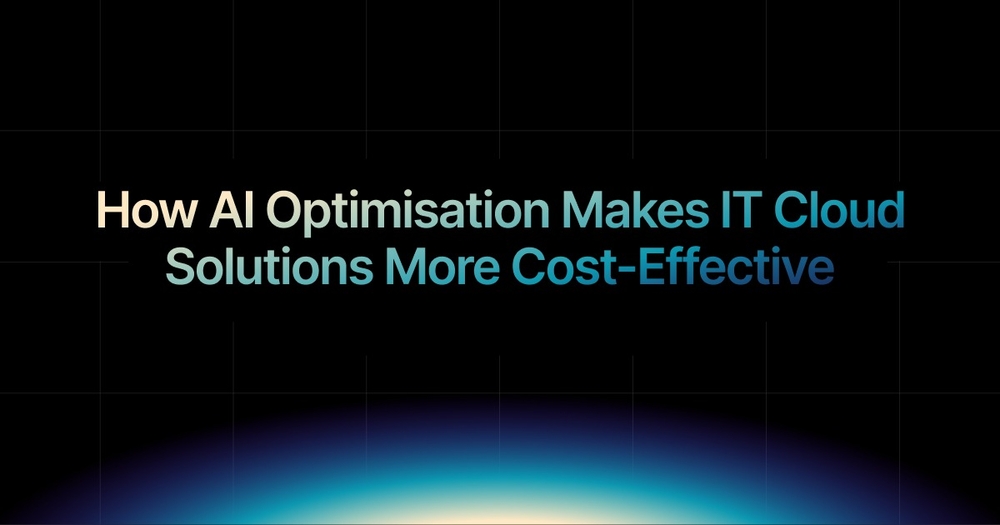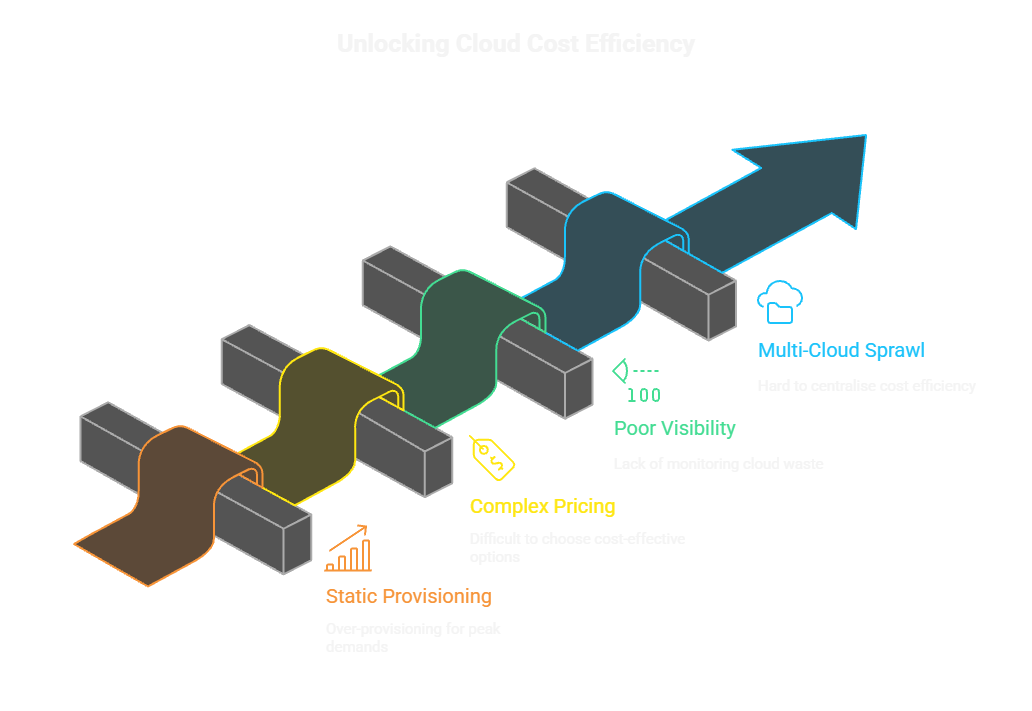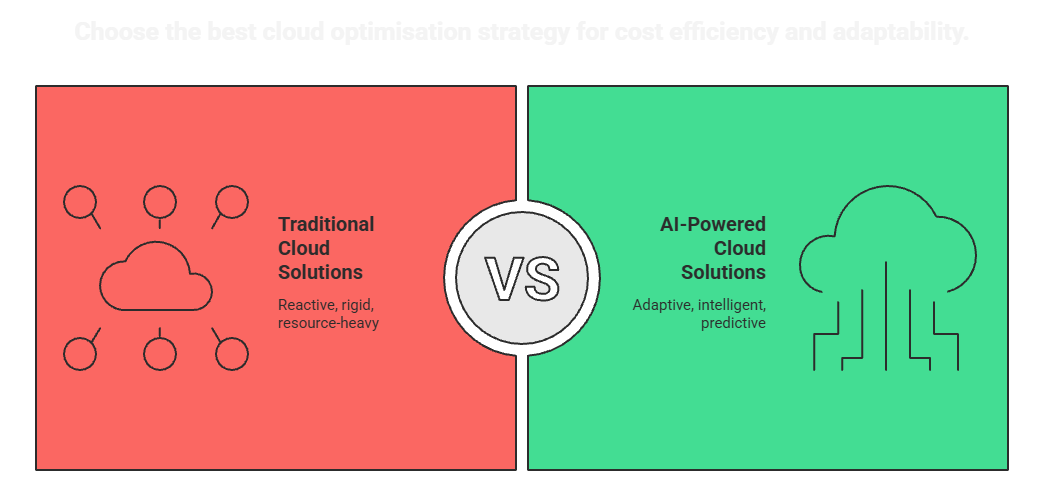Published
- 15 min read
How AI Optimisation Makes IT Cloud Solutions More Cost-Effective?

Organisations worldwide are embracing IT cloud solutions, drawn by promises of agility, scalability, and speed. Yet, as cloud adoption grows, so does scrutiny, especially from the boardroom. Cloud spending is becoming an increasingly boardroom-level concern, and for good reason: the numbers are eye-opening.
Recent data reveals that 21–50% of cloud expenditure is wasted annually, a striking figure reported by 78% of organisations surveyed.
IDC estimates that even a conservative 10–30% of cloud spending ends up wasted due to unused or mismanaged resources.
Meanwhile, Flexera’s 2025 State of the Cloud report finds that a massive 84% of organisations struggle to manage cloud spend, with rising budgets only intensifying the cost pressure.
Here’s another striking stat: In 2025, about 21% of enterprise cloud infrastructure spend, some $44.5 billion, is wasted on underutilised resources.
These numbers aren’t just line items; they are warnings that mismanaged cloud resources have a real impact.
So why the waste?
There’s more to it than just paying for unused servers.
Complex pricing models, overprovisioning by default, and poor visibility into real-time usage all contribute. And as companies expand into multi-cloud or containerised environments, the complexity (and cost leakage) only balloons.
At this intersection of promise and expense, cloud efficiency becomes not just a technical goal, but a strategic imperat
ive. With traditional IT cloud solutions often falling short, there’s a growing need for smarter, more efficient approaches, particularly those leveraging AI in cloud to reduce cloud costs.
To explore how this plays out in practice, let’s take a look at how legacy models struggle, and why AI‑powered optimisation is emerging as the cost-savvy answer.
Why Traditional IT Cloud Solutions Struggle With Cost Efficiency?
 The convenience and flexibility of IT cloud solutions have revolutionised the way businesses scale infrastructure, but they’ve also introduced a silent inefficiency: most teams are still running cloud environments with the outdated playbook.
The convenience and flexibility of IT cloud solutions have revolutionised the way businesses scale infrastructure, but they’ve also introduced a silent inefficiency: most teams are still running cloud environments with the outdated playbook.
At first glance, IT cloud solutions promise endless scalability and flexibility. Spin up a server in seconds, add storage as needed, and expand globally with just a few clicks. But beneath the convenience lies a hidden challenge: most businesses end up paying for capacity they don’t fully use.
According to Gartner, nearly 70% of cloud costs are wasted on idle or overprovisioned resources. The problem isn’t cloud itself, it’s the way traditional models are designed.
Here are some of the key reasons why cloud bills go out of control:
- Static provisioning: Teams often provision servers for peak demand, even though real usage rarely hits those peaks.
- Complex pricing models: With hundreds of instance types and billing variables, companies often default to “safe” (and costly) options.
- Poor visibility: Without proper monitoring, businesses struggle to see where cloud waste is happening.
- Multi-cloud sprawl: As organisations adopt different providers (AWS, GCP, Azure), it becomes harder to centralise cost efficiency.
“Most organisations still plan infrastructure like they’re buying hardware, overestimating to be safe, and then forgetting to optimise,” explains Corey Quinn, Chief Cloud Economist at The Duckbill Group
In traditional cloud environments, manual oversight is the norm. Engineers often have to manage auto-scaling policies, monitor usage manually, and react to performance issues after they’ve happened.
This reactive approach to cloud cost management makes optimisation difficult, especially at scale.
Another sticking point? Long-term contracts and misaligned pricing models.
To lower costs, teams often commit to Reserved Instances or enterprise discounts with cloud providers like AWS. But if business needs shift, as they often do, those savings disappear, and companies end up locked into underutilised capacity.
To lower costs, teams often commit to Reserved Instances or enterprise discounts with cloud providers like AWS. But if business needs shift, as they often do, those savings disappear, and companies end up locked into underutilised capacity.
These challenges are even more apparent in VM-based hosting environments, where every change (from scaling to billing) requires hands-on management.
This is where modern, AI-enhanced platforms have a distinct edge, not just in terms of performance, but in ensuring true cloud efficiency.
For finance leaders, forecasting cloud bills has become harder than predicting revenue. For engineering teams, it means walking a tightrope between ensuring uptime and trying to reduce cloud costs.
That’s why many organisations are now looking beyond raw infrastructure and asking: What if IT cloud solutions could be smarter about resource usage by default?
The AI Advantage in Modern Cloud Optimisation
 If traditional IT cloud solutions are reactive, rigid, and resource-heavy, AI-powered cloud solutions are their adaptive, intelligent counterpart.
If traditional IT cloud solutions are reactive, rigid, and resource-heavy, AI-powered cloud solutions are their adaptive, intelligent counterpart.
With cloud costs rising and environments becoming more complex, artificial intelligence is no longer a futuristic bonus; it’s quickly becoming the backbone of modern cloud cost optimisation strategies.
Instead of relying on manual monitoring or static rules, AI systems analyse real-time usage patterns, predict future demand, and adjust infrastructure automatically. This shift turns cloud management from reactive firefighting into predictive cost optimisation.
Here’s how AI is reshaping IT cloud solutions today:
- Predictive resource allocation: Algorithms forecast when workloads will spike or drop, scaling capacity before waste occurs.
- Smarter scaling: Unlike traditional auto-scaling rules (which trigger after thresholds are hit), AI adapts continuously to demand curves.
- Workload balancing: AI can move workloads across regions or instances to make the most cost-efficient choices.
A report by IDC predicts that by 2026, over 60% of enterprises will use AI-driven cloud optimisation tools to manage costs and performance. This trend highlights the growing recognition that AI in cloud solutions is not just about innovation, it’s about survival in a cost-conscious environment.
As Satya Nadella, CEO of Microsoft, put it during an earnings call:
“Every company is looking not just for more cloud, but for more value from the cloud.”
That “value” is increasingly tied to cloud efficiency, not just raw computing power.
Businesses don’t just want scale; they want scale that pays for itself. And that’s exactly where AI-powered cloud solutions stand apart.
Real-World AI Optimisation Strategies in IT Cloud Solutions
The promise of AI-powered cloud solutions becomes truly compelling when you see how it plays out in practice. Today’s leading IT teams are moving beyond manual tuning and leveraging intelligent systems that optimize not just scaling, but pricing, workload placement, and real-time infrastructure efficiency.
Let’s break down three core strategies where AI in cloud is actively reshaping how businesses reduce cloud costs.
Predictive Resource Allocation
One of the most impactful applications of AI in cloud environments is predictive resource allocation.
Rather than reacting to demand spikes or over-provisioning in anticipation, AI models use historical usage data, traffic patterns, and seasonal trends to automatically forecast upcoming compute requirements. This allows your infrastructure to scale just-in-time, ensuring enough resources are available when needed and dialled back when they’re not.
In other words, your infrastructure becomes elastic without needing your ops team to constantly babysit it.
Smarter Resource Optimisation
Cloud pricing models (especially on AWS) include a dizzying mix of On-Demand, Reserved Instances (RIs), Spot Instances, Savings Plans, and regional variations.
Manually monitoring and optimising these in real time is impractical. AI can take on this task by constantly evaluating pricing fluctuations and usage trends, then automatically switching to the most cost-effective model based on current usage.
Platforms like Kuberns integrate this strategy into their core, running continuous checks on AWS pricing and workloads. This allows organisations to dynamically shift compute workloads onto more favourable contracts, without renegotiating or reconfiguring their environments manually.
This intelligent approach is particularly powerful for startups, solo founders and freelancers.
Intelligent Workload Placement
Cloud costs don’t just depend on how much you use, but also where and how you run it.
AI-powered systems can evaluate infrastructure in real time to determine:
- Which regions offer the most cost-effective compute right now
- Whether workloads should run on CPU-optimised vs. memory-optimised instances
- How to spread workloads across multiple nodes for better efficiency
This dynamic workload balancing ensures maximum utilisation with minimal waste.
For example, AI might recognise that your low-priority background jobs can be batched and moved to cheaper spot instances or a lower-cost region during non-peak hours, without human intervention.
This approach is critical to achieving true cloud efficiency at scale.
AI-Led Approach to Cloud Cost Savings by Kuberns

The strategies we just explored, predictive allocation, smarter resource optimisation, and intelligent workload placement, aren’t just theoretical. They’re already being applied by new-generation platforms that treat cost efficiency as a core feature of IT cloud solutions, not an afterthought.
Kuberns is one example of this shift.
Instead of leaving teams to wrestle with manual cloud tuning or complex billing models, it builds AI-driven optimisation directly into the infrastructure layer.
The result? Businesses using Kuberns have reported up to 40% savings on AWS costs, without sacrificing performance
Here’s how it works in practice:
- Predictive scaling baked in: Workloads are right-sized automatically based on usage patterns, so you don’t pay for idle capacity.
- Smarter resource optimisation: The platform continuously evaluates the most cost-efficient options available on AWS and reallocates resources accordingly, so you’re never stuck overpaying.
- Transparent monitoring: Built-in dashboards make it easy for both engineering and finance teams to see where spend is going, helping align technical and business goals.
Instead of cloud cost management being a separate tool or a manual FinOps exercise, the optimisation happens by default.
That’s what makes this approach powerful; cost savings are embedded into the very way applications are deployed and run.
The Bigger Picture: AI Redefining IT Cloud Solutions
For years, the cloud conversation revolved around scale. How fast could you provision servers? How many regions could you deploy into? How quickly could you integrate new services?
Those questions still matter, but today a new one has taken centre stage: how cost-efficient are your IT cloud solutions?
AI is quietly but fundamentally reshaping the DNA of cloud computing.
What started as a set of tools for auto-scaling or anomaly detection is evolving into a fully autonomous infrastructure, capable of optimising resources, predicting future demand, and reducing waste without human intervention.
Modern AI-powered cloud solutions are answering that call. They’re no longer just about scalability—they’re about scalable efficiency. Cost transparency. Forecasting. Smarter provisioning that aligns with actual usage, not outdated estimates.
Platforms like Kuberns, which embed this AI-driven mindset at their core, aren’t just reacting to industry shifts. They’re part of the reason the industry is changing.
Building Leaner, Smarter IT Cloud Strategies
Cloud adoption isn’t slowing down, but the way organisations think about it is changing fast.
The spotlight is no longer just on speed or flexibility. It’s on cost efficiency. With budgets under pressure, every wasted resource feels like a missed opportunity.
The message for leaders is clear:
It’s time to demand IT cloud solutions that optimise themselves. Whether you’re running a startup trying to stay lean or an enterprise managing multi-region workloads, cost-aware platforms are becoming the new default.
Whether it’s through built-in autoscaling, predictive resource allocation, or smarter cloud spending tools, platforms like Kuberns are quietly enabling this shift, helping leaner teams do more with less.
The future of IT infrastructure is not just scalable, it’s cost-aware, AI-driven, and lean by design. And as the pressure to deliver more value with fewer resources increases, teams that embrace this model will be better positioned to scale responsibly and sustainably.
FAQs
1. What are IT cloud solutions?
A: IT cloud solutions refer to infrastructure and services like servers, storage, networking, and software, delivered over the internet. Instead of managing physical hardware, organisations use cloud platforms to scale resources on demand. These solutions support everything from application hosting to data processing and are core to modern digital operations.
2. Why are IT cloud solutions expensive?
A: While cloud platforms offer flexibility, they can become expensive due to overprovisioning, idle resources, complex pricing models, and a lack of real-time cost oversight. Many teams pay for peak usage or forget to scale down after traffic spikes, leading to significant cost inefficiencies.
3. How can AI reduce cloud costs?
A: AI helps with predictive scaling, smarter resource optimisation, and intelligent workload placement. This prevents waste and ensures businesses pay only for what they actually need.
4. What is predictive resource allocation in cloud computing?
A: It’s an AI-driven method of forecasting demand spikes and scaling resources ahead of time, reducing the need for costly, last-minute scaling.
5. How much can businesses save with AI-optimised cloud solutions?
A: Savings vary, but many organisations achieve between 20% and 40% cost reductions. Platforms like Kuberns integrate these optimisations directly with AWS hosting.
6. How do AI-powered cloud platforms differ from traditional cloud tools?
A: Traditional cloud tools often require manual configuration, scaling, and cost monitoring. In contrast, AI-powered platforms automate these tasks using predictive models and real-time analytics. They make smarter decisions, like when to scale resources or switch to lower-cost compute options without human intervention, reducing waste and effort.
7. What are the risks of not optimising cloud costs?
A: Failing to optimise cloud costs can lead to budget overruns, poor ROI, and wasted resources. Unchecked cloud spend also slows down innovation, as teams may need to freeze hiring or delay projects to balance infrastructure expenses. Over time, it becomes a strategic liability, not just a technical inefficiency.
8. Can small teams or startups benefit from AI-driven cloud optimisation?
A: Absolutely. Small teams often benefit the most. AI handles complex cost management tasks that would otherwise require dedicated DevOps or FinOps roles, allowing lean teams to run production workloads efficiently without expanding their ops staff.
9. Is AI-based optimisation only useful for large-scale workloads?
A: No. While large-scale operations see dramatic savings, even smaller environments benefit from AI by avoiding idle resources, right-sizing services, and choosing optimal regions or instance types. AI scales with your infrastructure and becomes more accurate over time.